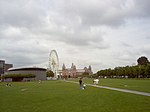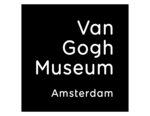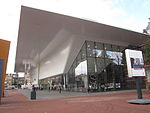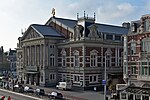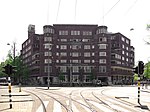International Colonial and Export Exhibition

The International Colonial and Export Exhibition (Dutch: Internationale Koloniale en Uitvoerhandel Tentoonstelling; French: Exposition Universelle Coloniale et d'Exportation Générale) was a colonial exhibition (a type of World's Fair) held in Amsterdam from May 1 to October 1, 1883. The event drew at least a million visitors and was the first international colonial exhibition, with 28 different nations presenting their colonial trade and wealth. The event was the brainchild of Edouard Agostini, a French entrepreneur. Agostini, who had previously been involved in organizing the 1878 Exposition Universelle in Paris, presented his plans to the city of Amsterdam and King William III of the Netherlands in 1880. The Dutch government was initially hesitant, but Agostini managed to secure funding from Belgian and French investors. The location chosen for the exhibition was an unused area of land behind the Rijksmuseum, which at that time was still under construction. This area is now Museumplein square. The main building was designed by the French architect Paul Fouquiau in "Moorish" style. It was constructed of wood covered with plaster and painted cloth, in order to give the impression of marble. Between the building's two large towers, a large cloth in "Indian" style was hung, with plaster heads of elephants and other animals. The building contained pavilions representing 28 different nations, including France, Germany, the United Kingdom, Belgium, Japan, the United States, China, Canada, the Ottoman Empire, Siam (Thailand), Transvaal, and the host country, the Netherlands. Items on show in the main building included a telephone, wood- and metalworking machines, and a safe large enough to fit eight people. The building's colonial section presented products such as tobacco and rubber, as well as a reconstructed Javanese-style settlement (kampung) with "natives". At that time, it was not considered degrading or racist to put humans on display; in fact, it became a regularly featured spectacle at such exhibitions (see further: Human zoo). Other structures included a music pavilion; the pavilion of the city of Amsterdam; the Dutch colonial pavilion; a Japanese bazar; various shops; and Dutch, English and German restaurants. In front of the Dutch colonial pavilion was a statue of Jan Pieterszoon Coen who, as governor-general of the Dutch East Indies, played a large part in the Dutch conquest of the Indonesian archipelago. A canal with a bamboo bridge and a Chinese junk intersected the exhibition grounds.
Excerpt from the Wikipedia article International Colonial and Export Exhibition (License: CC BY-SA 3.0, Authors, Images).International Colonial and Export Exhibition
Gabriël Metsustraat, Amsterdam Zuid
Geographical coordinates (GPS) Address Nearby Places Show on map
Geographical coordinates (GPS)
| Latitude | Longitude |
|---|---|
| N 52.357 ° | E 4.881 ° |
Address
Zigeunermonument - Hel en Vuur
Gabriël Metsustraat
1071 EB Amsterdam, Zuid
North Holland, Netherlands
Open on Google Maps
